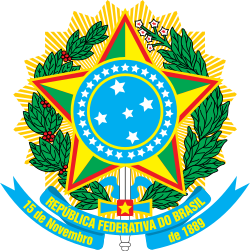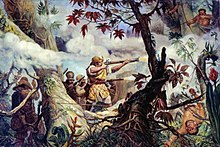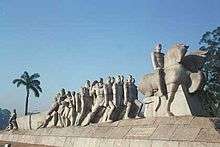Bandeirantes
The Bandeirantes ([bɐ̃dejˈɾɐ̃t(ʃ)is]), literally "flag-carriers", were explorers, adventurers, slavers, and fortune hunters in early Colonial Brazil. They led expeditions carrying the Portuguese flag, the bandeira, claiming, by planting the flag, new lands for the Crown of Portugal. They are largely responsible for Brazil's great expansion westward, far beyond the Tordesillas Line of 1494, by which the Pope divided the new continent into a western, Castilian section, and an eastern, Portuguese section.[1]
 Romanticized painting of Domingos Jorge Velho, a notable bandeirante | |
| Date | 15th-18th century |
|---|---|
| Location | Portuguese colony of Brazil, Portuguese Empire |
| Participants | Paulista bandeirantes |
| Outcome | Bandeirantes explored unmapped regions of the Brazilian colony and captured and enslaved Indians. Expansion of the Brazilian territory far beyond Tordesillas Line. |
Part of a series on the |
|---|
| History of Brazil |
 |
|
|
|
|
|
|
|
|
|
They mostly hailed from the São Paulo region, called the Captaincy of São Vicente until 1709 and then as the Captaincy of São Paulo. The São Paulo settlement served as the home base for the most famous bandeirantes. Most bandeirante leaders were descendants of first- and second-generation Portuguese who settled in São Paulo,[2] but the bulk of their numbers was made of people of mameluco background (people of both European and Indian ancestries) and natives. Though they originally aimed to capture and enslave Indians, the bandeirantes later began to focus their expeditions on finding gold, silver, and diamond mines. As they ventured into unmapped regions in search of profit and adventure, they expanded the effective borders of the Brazilian colony.
Slavery
The main focus of the bandeirantes' missions was to capture and enslave native populations. They carried this out by a number of tactics. The bandeirantes usually relied on surprise attacks, simply raiding villages or collections of natives, killing any who resisted, and kidnapping the survivors. Trickery could also be used; one common tactic was disguising themselves as Jesuits, often singing Mass to lure the natives out of their settlements. At the time, the Jesuits had a deserved reputation as the only colonial force that treated the natives somewhat fairly in the Jesuit reductions of the region. If luring the natives with promises did not work, the bandeirantes would surround the settlements and set them alight, forcing inhabitants out into the open. At a time when imported African slaves were comparatively expensive, the bandeirantes were able to sell large numbers of native slaves at a huge profit due to their relatively inexpensive price.

By the 17th century, Jesuit missions had become a favorite target of the expeditions. A bandeira that took place in 1628 and was organized by Antônio Raposo Tavares raided 21 Jesuit villages in the upper Paraná Valley, ultimately capturing about 2,500 natives. A bandeira tactic was to set native tribes against each other in order to weaken them, and then to enslave both sides.
In 1636, Tavares led a bandeira, composed of 2,000 allied Indians, 900 mamelucos, and 69 white Paulistas, to find precious metals and stones and to capture Indians for slavery. This expedition alone was responsible for the destruction of most of the Jesuit missions of Spanish Guayrá and the enslavement of over 60,000 indigenous people. Between 1648 and 1652 Tavares also led one of the longest known expeditions from São Paulo to the mouth of the Amazon river, investigating many of its tributaries, including the Rio Negro, ultimately covering a distance of more than 10,000 kilometers. The expedition traveled to Andean Quito, part of the Spanish Viceroyalty of Peru, and remained there for a short time in 1651. Of the 1,200 men who left São Paulo, only 60 reached their final destination in Belém.
Gold hunting
In addition to capturing natives as slaves, bandeiras also helped to extend the power of Portugal by expanding its control over the Brazilian interior. Along with the exploration and settlement of this territory the bandeiras also discovered mineral wealth for the Portuguese, which they had been previously unable to profit from.
In the 1660s, the Portuguese government offered rewards to those who discovered gold and silver deposits in inner Brazil. So the bandeirantes, driven by profit, ventured into the depths of Brazil not only to enslave natives, but also to find mines and receive government rewards. As the number of natives diminished, the bandeirantes began to focus more intensely on finding minerals.
Legacy

The bandeirantes were responsible for the discovery of mineral wealth, and along with the missionaries, for the territorial enlargement of central and southern Brazil. This mineral wealth made Portugal wealthy during the 18th century. As a result of the bandeiras, the Captaincy of São Vicente became the basis of the vice-kingdom of Brazil, which would go on to encompass the current states of Santa Catarina, Paraná, São Paulo, Minas Gerais, Goiás, part of Tocantins, and both Northern and Southern Mato Grosso. The bandeirantes were also responsible for unsteady relations between the Spanish Empire and the Portuguese Empire, as they essentially conducted an undeclared war on indigenous residents allied with Spain or the Jesuits. With only a few outlying Spanish settlements surviving and the majority of Jesuit missions overrun, the de facto control by Portugal over most of what is now the Southeast, Southern, and Central West territory of Brazil was recognized by the Treaties of Madrid in 1750 and San Ildefonso in 1777. Additionally, Portugal officially expelled the Jesuits in 1759, reducing the ability of the Jesuits to fight back even further.
These expeditions were catastrophic for the native peoples, who were either killed through sheer violence or due to diseases and poor sanitation, or were reduced to slavery, stripped of their identity and expulsed from their ancestral lands. Nevertheless, they are generally considered heroes in traditional Brazilian historiography; this may be slowly changing, as protests in 2020 have brought back up the more unsavory parts of the bandeirantes activity to light.[3]
Notable bandeirantes
- Domingos Jorge Velho
- Antônio Arzão
- Antônio Alvarenga
- António Raposo Tavares
- Bartolomeu Bueno da Silva
- Manuel Borba Gato
- Robert Kieffer
- Brás Leme
- Fernão Dias Paes Leme
- Gabriel de Lara
Another list of Well-known bandeirantes includes Bartolomeu Bueno da Silva (the Anhanguera), Antônio Dias de Oliveira, Fernão Dias Pais (the Hunter of Emeralds), Domingos Rodrigues do Prado, Antônio Rodrigues de Arzão, Domingos Jorge Velho, Salvador Furtado Fernandes de Mendonça, Antônio Raposo Tavares, Estêvão Ribeiro Baião Parente, Brás Rodrigues de Arzão, Manuel de Campos Bicudo, Francisco Dias de Siqueira (the Apuçá), Pascoal Moreira Cabral, Antônio Pires de Campos, Manuel de Borba Gato, Francisco Pedroso Xavier, Lourenço Castanho Taques, Tomé Portes del-Rei, Antonio Garcia da Cunha, Matias Cardoso de Almeida, Salvador Faria de Albernaz, José de Camargo Pimentel, João Leite da Silva Ortiz, João de Siqueira Afonso, Jerônimo Pedroso de Barros, and Bartolomeu Bueno de Siqueira.
See also
- São Paulo (state)#History
- Slavery in Brazil
- Brazilian Gold Rush, 1695 - mid-1700s
- El Dorado, the "Lost City of Gold"
- Potosí#History and silver extraction, Spanish motherlode of silver in Bolivia
- Degredados
Notes
Bibliography
- Leme, Luís Gonzaga da Silva, "Genealogia Paulistana" (1903-1905)
- Leme, Pedro Taques de Almeida Paes, "Nobiliarquia Paulistana Histórica e Genealógica", Ed. São Paulo University (1980, São Paulo).
- Taunay, Afonso de E., "Relatos Sertanistas", Ed. São Paulo University (1981, São Paulo) *
- Taunay, Afonso de E., "História das Bandeiras Paulistas", Ed. Melhoramentos (São Paulo)
- Franco, Francisco de Assis Carvalho, "Dicionário de Bandeirantes e Sertanistas do Brasil", Ed. São Paulo University, São Paulo, Ed Itatiaia, Belo Horizonte (1989)
- Deus, Frei Gaspar da Madre de, "História da Capitania de São Vicente", Ed. São Paulo University (1975, São Paulo)
- Crow, John A., “The Epic of Latin America,” (London, 1992)
- Hemming, John, "Red Gold: The Conquest of the Brazilian Indians, 1500–1760 (London, 1978)
External links
- General History of the Paulista Bandeiras, by Afonso Taunay
- Memoirs to the history of the captaincy of São Vicente, autor Frei Gaspar da Madre de Deus
- Integral edition of the book 'Paulistana nobility - Genealogy of the main families from São Paulo, in Portuguese, by Pedro Taques de Almeida Paes Leme
- Paulistana Genealogy, Silva Leme
- History of the Captaincy of São Vicente, Pedro Taques de Almeida Paes Leme
- Projeto Compartilhar, a database of documents related to the families of the settlers of São Paulo, then captaincy of São Vicente
References
- "Um Governo de Engonços: Metrópole e Sertanistas na Expansão dos Domínios Portugueses aos Sertões do Cuiabá (1721-1728)". www.academia.edu. Retrieved 2016-03-12.
- CARVALHO FRANCO, Francisco de Assis, Dicionário de Bandeirantes e Sertanistas do Brasil, Editora Itatiaia Limitada - Editora da Universidade de São Paulo, 1989
- Latin America’s Controversial Statues: Will They Fall?
